Back to > Major Fruits | Minor Fruits | Underutilized Fruits
![]()
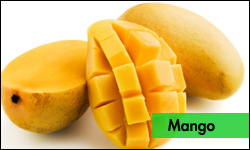 |
||
|
|
||
Harvesting:
The mango is the apple of the tropics, and one of the most commonly eaten fruits in tropical countries around the world. To ensure that mangoes can be commercially distributed, proper harvesting and handling procedures must strictly be followed to maintain the quality and freshness of the fruit. Bagging of fruits is carried out while they are in the tree to prevent insect pests from damaging the fruits.
Fruit Harvest: Mango fruit matures in 100 to 150 days after flowering. The fruit will have the best flavor if allowed to ripen on the tree. Ripening fruit turns the characteristic color of the variety and begins to soften to the touch. Commercial marketability requires 13% dissolved solids (sugars). When the first fruit shows color on tree, all of that size fruit or larger may be removed; repeat when remaining fruit colors. Do not store below 50° F. The fruit ripens best if placed stem end down in trays at room temperature and covered with a dampened cloth to avoid shriveling.
Expected yield for each variety (data from Kununurra)
| Year 3 (kg) | Year 4 (kg) | Year 5 (kg) | Year 6 (kg) | Year 7 (kg) | Year 8 (kg) | Average mature tree | |
| Kensington | 6 | 19 | 32 | 45 | 57 | 70 | 70 |
| Irwin | 8 | 27 | 47 | 66 | 85 | 105 | 110 |
| R2E2 | 0 | 11 | 22 | 33 | 44 | 55 | 71 |
| Haden | 3 | 12 | 21 | 30 | 39 | 48 | 104 |
| Keitt | 0 | 14 | 28 | 42 | 56 | 70 | 107 |
| Kent | 2 | 6 | 10 | 15 | 19 | 23 | 69 |
Maturity:Color change from green to yellow, and the development of “shoulders” on the stem end of the fruit are the best indicators of maturity. Also, the fruit flesh turns from white to yellow starting at the endocarp and progressing outward to the skin during maturation. When the flesh is yellow to half that distance, the fruit can be harvested and will ripen normally off-tree. Fruit are not ripe at this stage, but picked firm to withstand shipment. If picked before this stage, flavor never develops and fruit are more susceptible to chilling injury and hot water damage during post-harvest fruit fly control. If fruit are left on tree until ripe, they often develop physiological breakdown termed “soft nose”, “jelly seed”, or “spongy tissue”. Fruit removal force may also be assessed by individual pickers to determine ripeness.
Harvest Method: Mangoes are hand-harvested, simply by snapping-off fruits from peduncles in less-developed plantings, or by clipping peduncles 4 inches above the fruit when intended for export. This allows the milky, toxic latex to ooze from the stem without touching the fruit surface. Pickers use poles with cloth bags at the end to reach fruit high in the tree, or ladders and hydraulic lifts in developed countries. Mango is harvested 120 days after flower induction.
Post Harvest Handling and Packaging
Grading: Fruits are graded according to their size, weight, colour and maturity. It has been observed that bigger size fruits take 2-4 days more time in ripening than smaller ones. Hence, packaging of smaller fruits with larger ones should be avoided to achieve uniform ripening. Immature, overripe, damaged and diseased fruits should be discarded.
Packaging: Wooden boxes are commonly used for packaging and transportation of mango fruits. Under dynamic transport conditions vibration results in bruising, decay and low price of fruits. Further, too much ventilation affects the quality of fruits due to shrinkage, loss in weight, colour, etc. To overcome these problems CFB Boxes of 5 kg and 10 kg capacity for packing and shipping of mango fruits have been used successfully and extensively for export purposes.
Paper scraps, newspapers, etc., are commonly used as cushioning material for the packaging of fruits which prevent them from getting bruised and spoiled during storage and transportation. Polythene (LDPE) lining has also been found beneficial as it maintains humidity which results in lesser shrinkage during storage. Wrapping of fruits individually (Unipack) with newspaper or tissue paper and packing in honey comb structure helps in getting optimum ripening with reduced spoilage.
Storage: Storage is essential for extending the consumption period of fruits, regulating their supply to the market and also for transportation to long distances. The mature green fruits can be kept at room temperature for about 4-10 days depending upon the variety. Shelf life of fruits could be extended by precooling, chemical treatments, low temperature, etc.
The harvested fruits are precooled to 10-12oC and then stored at an appropriate temperature. The fruits could be stored for 3-4 weeks in good condition at low temperature. Preventing chilling injury at low temperature can be overcome by keeping the fruits in 0.5 per cent ventilated polythene bags.
Calcium infiltration is an improved technique of extending the storage life of fruits . The fruits are kept in calcium chloride solution (4%) at sub- atmospheric pressure of 500 mm Hg for 5 minutes. The treated fruits can be stored at low temperature (12oC) for 27 days.
It is a general practice to harvest fruits early in the season (premature stage) to capture early market. These fruits do not ripe uniformly without any ripening aid. Such fruits could be ripened uniformly by dipping in 750 ppm ethrel (1.8 ml / litre) in hot water at 52+2oC for 5 minutes within 4-8 days under ambient conditions. Mature fruits can similarly be ripened with lower doses of ethrel for uniform colour development.
Transportation: The truck has been adopted as the most convenient mode of transport due to its easy approach from the orchards, but they were unsuitable for transporting live material as they exert lot of pressure on the fruits. Therefore, refrigerated vans/ containers may be useful for long distance transport and export purposes as they would help in reducing the postharvest losses.
Ripening and Storage
Removal of field heat is critical in maintaining fruit quality and for achieving maximum storage life by forced air cooling. For maximum storage life the fruit should be stored at 13o Celsius. This is the most suitable temperature for transportation without the risk of causing chill damage to the skin.
Fruit is generally put into ripening rooms at the market and gas ripened. This gives more uniformed ripening throughout the tray. Optimum temperatures for ripening mangoes range from 20 to 23 o C. If temperatures are high, fruit will not develop yellow background color. Rather it will tend to ripen in a less attractive dull yellow/green color. If temperatures are too low then sometimes fruit flavor can suffer.
Commercially, mangoes (e.g., Kensington Pride) may be stored for three weeks by dipping in a prochloraz (Sportak®) solution for controlling anthracnose and other postharvest rots then maintained at 13o Celsius. Both in storage and transport, the temperature must not fall below this level, unless under strictly controlled conditions where the temperature is gradually reduced. The critical minimum storage temperature for most other varieties has not yet been determined. Processed mangoes or mango pulp can be stored at 0o to 1o Celsius for up to six weeks. In the home, sliced mango can be stored in a freezer at minus 18o Celsius for up to 18 months. Stems are trimmed to 0.6 cm prior to packing in 12 kg. boxes containing 8-20 fruits, depending on size. Fruit are culled by hand, removing diseased and off-grade fruit. In countries where fruit flies are endemic, fruit are dipped in hot water for fruit fly and anthracnose control. Hot air treatments can be used to meet export requirements as well. Resins left on fruits cause black lesions which may lead to rot. Fruits are stored for 15 days at 24 ºC and RH of 85-90%. Ethylene is often supplied in more sophisticated operations to accelerate color development (by 3-8 days) and allow more uniform ripening. Refrigerated van used by big companies in transporting the fruits. Controlled atmosphere technologies to preserve quality or prolong shelf-life.
Mangoes are subject to chilling injury, therefore, they must not be stored at <13 ° C. Storage life is only 2-3 weeks under optimal conditions.
Processed Products:
Mango is an extremely versatile fruit when it comes to processing. The flesh can be used for canning, juicing, drying, freezing and as fresh slices for the pre-prepared fruit salad market. Frozen or preserved pulp provides the raw material for use in fruit juice, yoghurt fruits and ice confectionery. While the raw fruits are utilized for products like chutney, pickle, amchoor, green mango beverage, etc. ripe ones are used in making pulp, juice, nectar, squash, leather, slices, etc.
a) Raw mango products
Mango fruits during early stages of growth are commonly used for sweet or sour chutney. Astone hardening stage they are suitable for making amchoor, pickle, slices, green mango beverages, etc.
(b) Ripe mango products
Ripe mango fruit has characteristic blend of taste and flavour. It contains=amount of sugar, pectin, carotenoids, etc., but due to short storage life of mango, the following products habe to be prepared immediately.
(i) Pulp: Fully ripe mangoes are washed, peeled and cut into slices. The slices are then homogenized into pulp which is filtered through a sieve to remove the fibres. The pulp is heated to 76-78oC and 2 g citric acid and 2 g potassium metabisulphite are added per kg of pulp. It is filled in sterilized glass jars and lids are sealed with wax.
(ii) Beverages (Juice and Nectar) : Mango juice may be prepared by mixing 1/3 of fresh or stored pulp with 2/5 of water. Sugar and citric acid are so added that total soluble slides (T.S.S.) and acidity of the product reaches to 15 per cent and 0.3 per cent, respectively. The mixture is heated to 95oC, filled hot in clean, sterilized bottles and crown corked. The bottles are sterilized in boiling water for 10-15 minutes, cooled to room temperature and stored. The procedure for nectar preparation is similar to that of juice except that the pulp percentage is reduced to 15 %.
(iii) Squash: Squash is prepared by mixing 1 kg of pulp with sugar syrup (1 kg sugar in 750 ml water) . The whole mixture is heated to 76-78oC and then 25-30 g citric acid is added to it. The prepared squash is filled in clean, sterilized bottles and stored. At the time of use, three parts of water is added to one part of squash.
(iv) Slices: Firm ripe mango fruits are peeled and cut into slices. The slices are then transferred to boiling syrup containing 40 per cent sugar, 0.3 per cent citric acid and 350 ppm sulphur dioxide for 5 minutes. The slices are filled in clean jars and boiling syrup is poured until all the slices are covered. Finally, the jars are covered with lids and sealed with wax.
(v) Mango Leather or Aam Papad: Homogenized mango pulp is taken and potassium metabisulphite is added to it @ 2 g per kg of pulp. The pulp is then spread on trays smeared without and kept for drying in solar dehydrator or sun. After drying of one layer, another layer is spread over it and kept for drying. The process is repeated as per desired thickness. Finally they are cut into pieces and wrapped in butter paper or polythene cellophane sheet.
(vI) Fresh-cut mangoes: Recent developments in the pre-prepared fruit salad market offer opportunities for processing of seconds. Although the technology is relatively new for maintaining the shelf life of pre-cut fruit, it does have significant market potential. Mangoes could be an attractive addition to the growing market for fresh-cut produce, but browning and drying have prevented such marketing. However, researchers at the USDA-ARS Horticultural Crops Quality Laboratory,USA found that fresh-cut mangoes could be preserved by treating the slices with a combination of hexylresorcinol, iso-ascorbic acid and potassium sorbate (all food-safe compounds derived from natural products) and storing the slices in plastic containers to prevent drying. Treating whole fruits with methyl jasmonate (an inexpensive product derived from plant essential oils) prevents the development of chilling injury during cold storage and hence markedly increased fruit quality after storage.
Processed mango products
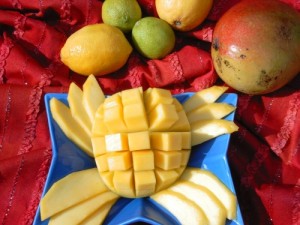 |
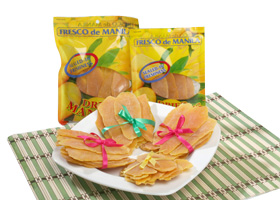 |
 |
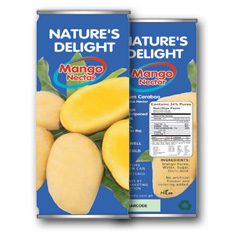 |
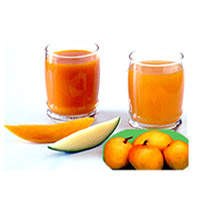 |
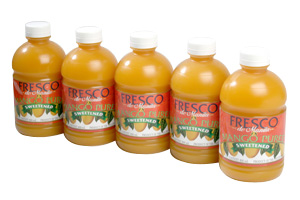 |
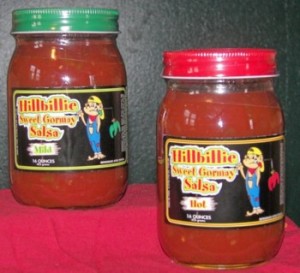 |
 |
Reference:
- Diczbalis, Y., Wicks, C. and Landrigan, M. (1997). Heat sums to predict fruit maturity in mango (cv. Kensington Pride). Draft report for HRDC FR605 NTDPI&F.
- Johnson, P.R. and Robinson, D.R. (1997). An evaluation of mango (Mangifera indica L.) cultivars and their commercial suitability for theKimberley. Department of Agriculture. 21/97 ISSN 1326-4168 Agdex 234/34.
- Morton, J. 1987. Mango. p. 221–239. In: Fruits of warm climates. Julia F. Morton,Miami,FL.
- P.R. Johnson and D. Parr. Mango growing in Western Australia. Bulletin 4348
- Maxwell, Lewis S. and Betty M. Maxwell. Florida Fruit. Lewis S. Maxwell, Publisher. 1984. pp. 61-63
- Samson, J. A. Tropical Fruits. 2nd ed. Longman Scientific and Technical. 1986. pp. 216-234.
- Sherrard, J., Johnson, P.R. and Luke, G. (1997). Mango irrigation requirements for the Broome and Ord irrigation areas of Western Australia. Department of Agriculture. Draft report.
- Sites on Mango
- Subtropical/Trop. Fruit Crops Database: http://www.agnic.nal.usda.gov/agdb/stropfc.html
- Mango Produce Facts Linked from the Postharvest Outreach Program, UC Davis
- Mango Overview, Propagation, And Agroforestry Uses Linked from Cornell University
- All About Mangoes
- Mango Fruit Facts and Mango Publications Courtesy of California Rare Fruit Growers.
- Mango Information Linked from NewCrops, Purdue University.
- Mango Tip Burn And Sunburn Images Linked from Texas A & M.
- Mango Production Regions Linked from the Dept. of Agronomy, U.C. Davis
- Mango-Research and Development A site on various aspects related to manoes
- Mango recipes, history, varieties etc — http://freshmangoes.com. or http://freshmangoes.com/mangonews/
- Mango Index Linked Information Mango Produce Facts
- Mango Food Resource (http://osu.orst.edu/food-resource/index.html) Oregon State University, Corvallis
- Postharvest Handling of Pickling Mango
- Mango an introductory description http://www.safari.net/~lychee/mango.htm
- Mangoes – Preparation and nutrition information – Preparation, cooking, and nutritional information for Mangoes
- Mango Botanical Description
- Subtropical/Tropical Fruits Menu University of Florida.
- Subtropical/Tropical Fruit Crops National Agriculture Library, USA
- Market Asia – Technical Information (Postharvest and Market Guides) http://www.marketasia.org/tech
- Mango Mania! is page devoted to the king of fruits http://www.delphis.dm/mango.htm
- http://www.destinationtropicals.com/tropical_plants/plant_43.asp
- http://mangoseedling.com/culturalmgmt.html
